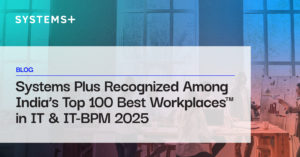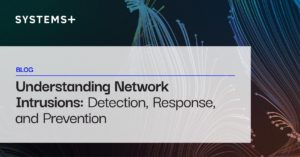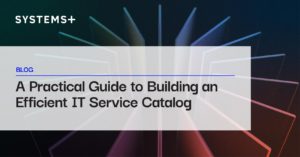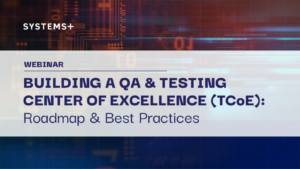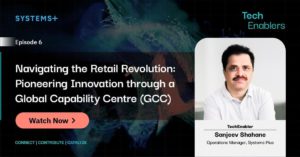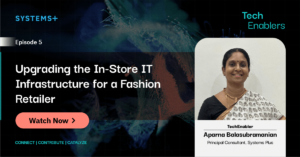Amay:
Hey, everyone. Welcome to Enabling Digital with Systems Plus. I'm your host, Amay, and today we have Eric from the Wilmott Cancer Institute. He is the Executive Director of Technology Innovation. Welcome, Eric!
Eric:
Thank you for having me.
Amay:
All right, so Eric, you've had a very interesting career. It would be great to understand what has led to your current role in healthcare IT today, and what does your role encompass today?
Eric:
It’s been a pretty unique career, especially for someone in the healthcare space. I started my career out in the outpatient pharmacy here at the University of Western Medical Center, which a lot of people don't know because I don't put it anywhere. But I did this while I was in college doing a computer science degree. I think it's where I got my first exposure to healthcare, which set up the rest of it. But eventually, I graduated and found a job in the pathology department as one of the first computer programming jobs that I had. It's also where I realized that, at least back then, so this is over 20 years ago, computer programming as defined by healthcare, is a little different than what I was. I was a true developer. I could back in full stack and all that stuff. But I think back then, it was more systems configuration is what we would consider it, dealing with the HRs etc. I like to joke that I'm the grandfather of instant electronic eligibility. Before the HRs had all of the ability to do that, I had that up and running for UMC. That caught the eye of a large software vendor in the United States who ended up offering me a position there.
It's hard because I think the reason that a lot of people don't leave the healthcare space once they're in it is the stability. I mean, there's very rarely layoffs or anything like that. But I had a really great mentor who walked me through that and encouraged me to go. I took that job, and it was one of the first of several cross-country moves that I did in my career. I ended up moving down to Florida and I started a job there as a traveling programmer. I was flying all around the United States three times a week.
Amay:
Traveling programmer?
Eric:
Yeah, traveling. Ee were entering in different healthcare organizations, attempting to help them with whatever it is that they needed.
Amay:
The travel part was you had to be on site because of just security type of reasons?
Eric:
I don't know that it was necessarily security, some of it was. I think that people just wanted someone there at the time. I mean, this is still early in my career, 20-ish years ago, maybe 19 years ago. So, I don't know, but they definitely wanted to be on site. I was in, no exaggeration, probably 40 to 50 of the top institutions in America. That's where I really learned what worked and what didn't, that informed a lot of my later career. But eventually traveling that much, it's the little things that get you. I was sick a lot because you're in and out of these organizations and traveling three times a week. It wears on you a little bit. So, I ended up taking a job back in New York at the University of Rochester again, when one opened up after a few years of that. So, I ended up back there, but it was great. There's a reason I've gone back three times now, because it's a great organization. But I started to realize I wasn't made for just doing a singular development job. After traveling all over the place, I wanted to be more innovative.
Healthcare IT in general, isn't really that space. So, while I was working there, I decided that it would also be interesting to try a different industry. I went back and got a cybersecurity degree, and that was the third cross country trip. I ended up taking a job down in Louisiana this time, and I was lucky and privileged that I could start over because at that point, I was in senior roles and had some supervisory capacity as a developer. I started over as an analyst in the cybersecurity space and eventually worked my way up to leading teams and doing penetration testing all over the United States again, which was really fun because you're legally breaking into buildings and hacking people. But much like the way that it got all traveling as a programmer, that also gets really challenging as well.
Amay:
So, were you traveling?
Eric:
It was a lot of fun. I saw a lot of crazy things. I learned a lot, too, and that I still hold today. But eventually, at that point, I knew what I wanted to do. So now we're mid-career and I ended up having the great opportunity to come back to when Wilmot opened a position, and after I met with all the leadership there, they really... I think it was exactly what I wanted. I could be innovative, but I also could make an impact on the community because I realized that that's a big aspect of what I wanted to do as well. So, in the cancer space, this technology can do so much. That's how I got here.
Amay:
Okay, part of what you mentioned was during your first traveling stint working in healthcare, you saw a lot of organizations, and you saw what worked and what didn't. I know you have some opinions today on healthcare IT, where it is today, where it should be, how should people be operating, the level of innovation, some of those things. It would be great if you could share your thoughts on just the overall space today and where some of the gaps are.
Eric:
I don't think this would be too controversial of a statement, but I think healthcare technology in general is roughly 10 years behind the industry. I think there's some valid reasons for that, and then some reasons that are a little bit more challenging. I think valid reasons in the gap, with the advent of AI, everything's AI right now, right? There are some ethical concerns in healthcare, like how to use that and how to do those things. So, they slow that roll down where industry can steam roll forward. But from a gap perspective, I really think that, and I talk a lot about this, the gap is really foundational, and that's what people aren't necessarily recognizing, because I think there might be a lot of toxic positivity around this. We have severe data problems in healthcare- data interoperability problems. But I think that we haven't really figured out in mass, a lot of the data issues- curation, validation, and all of that in healthcare. I think what happens is, because of these grant mechanisms that some places have, they're working on AI, they're working on blockchain, they're working on VR, but they're working on it with a broken foot, because there’s no foundation. I think that we ignore that, it's often overlooked. But I think that's probably the biggest gap right now that I see.
Amy:
Right. One of the things you have said is easy access to data has been a problem. The foundations are fundamentally not there and because of that, everything just gets delayed. A simple process may take three to five days when it could take a day. What are some of the innovations you and your team are pioneering at Wilmott to solve some of these problems?
Eric:
Because of everything I just mentioned, and because of that breadth of experience that I saw, I came into this with an idea of what we would need to do to prevent that, at least internally. This only applies to us because your national level is different, but we built a Data Platform System we called Hyperion. The general idea of that was to correct some of the foundational issues so that we could more rapidly develop and iterate after. That was also the way that we identified some of the core gaps in that foundation, one of them being oftentimes IT groups don't have the staffing and they lack the funding to actually accomplish all the goals. The University of Rochester is something like 40,000, and probably overstate 35-40,000 employees, you have a lot of requests coming in, Wilmo, itself has several 1000 and all that kind of stuff is part of it. So, you have to have some mechanism, that you can lower the skill low enough that you can get this data, these reports, these complex analytics back out to the user in a reasonable timeframe, less than a day, hopefully. We did that by semantically redefining everything that was coming into the system, from the EHR, from the clinical trial systems, because that's sort of the other problem to have- 30 disparate systems that don't talk to each other on these things. It took a year or so to do this. There were a lot of nights doing this, too. But we redefined it all into really easy to define terms. One of the examples I love to use is, just a simple like poll of disease and age in the most common EHR on the market would take crossing 12 tables, and it's all over the place- that the things aren't named rightly in our system. So you don't necessarily have to even know healthcare to deal with that, we lower the skill low enough where now we can sort of focus on what matters more- getting actionable intelligence.
Amay:
How big was your team when you were building out?
Eric:
When I started, I was employee 1 on the team. We started building out so I would say we did it with about four FTs that first year. The teams are brilliant, and they're very dedicated. So, we built it out with that. And then there were some iterations, obviously, it was up in the first year, but it's not what it is. Eventually, we now have 12.
Amay:
Is Hyperion based off the big sort of cloud providers or some infrastructure that's out there, or is it because you're in healthcare, you can’t use some of the probably common technology that we use in other enterprises, right. What are some of the challenges that you faced?
Eric:
It's completely custom. The data model is completely custom, the base layer, the Esperanto layer is custom. I think that was one of the biggest challenges, though, because we originally had built this with an MS SQL system and all that kind of stuff we're putting it in. We were able to expand that technology quite a bit. We had originally done it on very little power equipment. I mean, I think we had spent $2,000 total. We had to find a way to import billions of lines of data off that equipment originally. And the way that we did it, we spent a lot of time, we coded a multi-threaded, multi processed approach with upstart routines, and all these things were going on, to try and now, the equipment's quite a bit larger, but it worked. I was able to keep things up to date in near real time.
It's still on PREM, although we can use the cloud now. When you get into genomic sequencing, now you're talking terabytes a day, that's why we switched to be able to burst to the cloud platforms for that kind of stuff. But yeah, most of it's still around.
Amay:
So you have Hyperion, it’s set up, you've got that good foundation, like you said, and now you get to do some of the more fun stuff, which is visualizing it, and then maybe, you know, attacking use cases. And I believe you've built a system called Canvas around that.
Eric:
So now that that foundation has done, that's how we've been able to push out so much, because it's so easy to code in it. One of the systems was Canvas, it was a geospatial analytical system that would allow any user to go in there and look up anything about our patient base internally. And if it was internal, it has to be someone on the New York State's registry, which we also had imported. All the incident rates, like New York statewide- they could select any demographic, any disease they wanted, if these people have been on clinical trials, or the mortality rates, and then plot those on a map. And that kind of led way to quite a few different discoveries. One being around lung cancer in a certain region here in upstate New York, where there seemed to be some disparity going on. But they used that data in that app to open a multimillion-dollar facility. It's been used, that technology specifically has been used in many, many different research ways.
Amay:
Is it the same for FTEs that built this from scratch?
Eric:
Now we have, although I would say the Canvas itself was built by one very brilliant developer. I like to joke that they're all given me imposter syndrome, even though I've been developing for 20 years.
Amay:
This is honestly, phenomenal, right? One guy building some of this, which is providing tremendous value. That's also one of the things I did notice about your team, when I was sort of doing my research was you have like a Head of Product, which you don't see. I would love if there's more sort of product people in those spaces. What led you to hire that person and have that person in your team and realize the importance?
Eric:
This comes from that breadth of experience too, he was actually the third higher I did or fourth, it was very early on. I think that a lot of our success is attributed to a few items, this being one of them. I think that anytime, especially in the healthcare space, where you do have thin budgets, and you do need to hire consulting, and you do need to do all these thing and priorities are shifting, sometimes daily, you need someone that is overseeing but especially with some of the leadership style that we use, we're not a command and control leadership style. Someone has to be there to keep me in check as well, to not go overboard and that's product. Someone who can go out there and interact with the different clients, figure out the scoping so that developers can focus on exactly what they need to do, which is also how Canvas can be built with one. We already had a clear scope for that. he had it already designed so I think it's a huge success, part of what we have what we've done, and I would really recommend that most people if you're going to be in the technology innovations within healthcare, you should consider getting some kind of product manager.
Amay:
I mean, I think, not just healthcare, a lot of the industries, there's fundamentally a disconnect between the technology team and the business oftentimes. Having somebody to help bridge that and then manage scope and prioritize things is important, otherwise, you just get too many moving threads at once.
Eric:
It really is, it's very helpful. My co-director is a practicing oncologist, and the product manager as well has 30 years of bench research. So, between both of them, we do sort of have that bridge, which has helped this team immensely too because I don't always understand whatever clinical aspect they're telling me. It's very helpful to have two people, especially like my co-director, who is also a brilliant data scientist in general. But having both of them really helps.
Amay:
You built Canvas, which was of immense value, but from what I understand, 2D was not enough, right. And you've said, I need one FTE to build me something now, your next amazing engineer to come and build things in 3D.
Eric:
You're going to hate us, but it was one FTE. It's not always the case with all our projects. The idea was with VR technology and AR technology, you can do a lot, and I don't think VR AR will ever obviously replace like traditional, but it's meant to enhance it in certain ways. There are a few things that I think it really enhances, one in that geospatial suite, you theoretically could code in some kind of collaboration in there. But to do this in VR, is really at another level than 2D. So being able to have a site, a researcher, which does happen in California, and then in one in New York, or across the world, it doesn't really matter, both in the same geospatial suite, moving that same map around and plotting like I think we have a cancer problem in the Southern Tier, something that is way more powerful, I think, than doing that in 2D, it's just not as easy because you'd have a Google Docs style, like people can see things, which is really like text. But when you're dealing with stuff like geospatial analysis, I think that that's quite a value added over. The other part of it is with VR, our current Canvas suite, you can have multiple maps side by side to compare and whatever. But you only have so much screen space to deal with. In VR, your viewpoint is much higher. So, we're able to bring not just the basic functionality of Canvas in but you could theoretically then bring in a lot of the analytics and have that side by side. I think the expanded view, and what you can show and how you can show it is actually quite a bit more powerful than they are.
Amay:
Do you have use cases where you're taking advantage of that third dimension that you can visualize data?
Eric:
We do. It's not in production yet. There are a few analytic items that need to be added and combining a certain systems because it's a different coding mechanism as well. So as a developer in healthcare, I can tell you, there's very little that you could ask me or tell me that I probably haven't seen in some way or couldn't look up. This is a bit different, though, I would say from my perspective, the reason that's different is because you still have that development layer when you're coding in VR and AR, traditional coding. But then there's a spatial awareness layer because you're in 3D. And I don't think I really have that, at least internally.
Then you have to have the math to make that work and all this stuff. I think if you're going to go down that road, you need someone that thinks that way.
Amay:
It's not just that you guys are building VR, but there's like collaborative VR, but I guess, in general, let's say we get very close near real time collaboration in the AR VR space, or next year, which I think is possible. With Apple, launching VR Pro and pushing that, hopefully, further down, how do you see this benefiting healthcare as an industry?
Eric:
I don't think it'll ever replace fully. But I think those collaborations are really huge, that there's training for surgeries and stuff that VR has always done, which is already amazing. But I think people really haven't gotten to that data space with VR AR yet, I think that's where we could benefit them the most. And we definitely know that the use cases, and it's in reality, for training, and then those mechanisms, but I don't think people have thought through a lot of that data collaboration or anything like that. I mean, you could also look at it from the standpoint of identifying security vulnerabilities. I think one of the things that you could take a look at his genomics, having those large data sets, they're visually color-coded, and are going to be used with VR as well. I think that's sort of the future. Like I said, probably it won't fully replace anything, obviously. But there's a lot of benefit.
Amay:
Looking outside of data, you know, the industry in general, what are some of the core trends you see over the next five years between AI, VR?
Eric:
I really hope that people get to those foundational layers, and that's not a really glamorous answer. To really get to these more glamorous things that people really should be focusing on the data, but they're not. Some of the things that I'm interested in for the future, the five years, CRDTs, stuff like that, because I think, blockchain for example, I was really interested in that for a while. But I think that there's just too much hesitation around that because of crypto even though it's not the same. But I think CRDT is a datatype kind of sort of accomplish the same goals there. So I'm interested in that. AI obviously, we're going to stop hearing about that for anytime soon.
Amay:
I think from a proprietary security perspective, you don't want to send your data unnecessarily outside. So, if you want to build your own models inside, you need those foundational layers, which a lot of companies, they just don't have it.
Eric:
In healthcare, you also need clean data in your interest. We've taken a lot of steps to clean data, but I mean, what if most institutions, you know, the race, ethnicity data is very bad? There's a lot of concern with AI, I think, at least internally.
Amay:
In general, if anybody in healthcare today wanted to go through this data transformation, any recommendations based on your own learnings and then how do they continue to keep data clean? What are some of the practices they can put in place to ensure this?
Eric:
I didn't mention it, but we built 1000s and 1000s of lines of data validation scripts, so you need to be careful, like, you can't automatically fix things. But the idea would be to proactively flag people if something looks off so that it can be corrected very quickly. And there's many ways that you can do that, that the EHR really should be doing, but they're not. We have access to 90 interfaces now. But I think it's really important to have a lot of those validation type scripts and routines built to try to keep it clean. Although it's sort of impossible, but you're just trying the best you can.
Amay:
Yeah, we try to be as good as we can. Awesome! Well, thanks Eric, for joining us.


